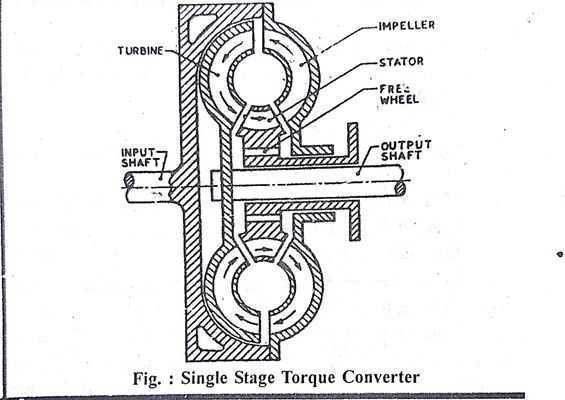Torque Converter
The torque converter is a device used for the multiplication of torque. It consists of:
(i) The impeller or the driving member,
(ii) The turbine or driven member,
(iii) The stator fixed to the frame through a freewheel.
Torque Converter Diagram
Torque Converter Working
When the engine is started, the impeller starts rotating, the oil from the impeller is pushed into the turbine. The oil, having high kinetic energy from the engine through the impeller hits the outer edge of the turbine. This force will increase with the rise of engine speed. once it's nice enough the turbine starts rotating and therefore the vehicle moves. The fluid from the turbine is made to strike a stator, which changes it’s direction suitably so that the oil leaving g the stator strike the impel [er in a favorable direction i.e. in the same direction in which the impeller is turning.
Thus repeated pushing of the turbine blades causes the torque on the turbine to increase, the phenomenon being called torque multiplication.
FUNCTIONS OF Torque converter
Its main functions are:
1. It transfers the facility from the engine to the transmission input shaft.
2. It drives the front pump of the transmission.
3. It isolates the engine from the load when the vehicle is stationary.
4. It multiplies the torque of the engine and transmits it to the transmission. It almost doubles the output torque.
Torque Converter Advantages
- No, wear moving parts.
- No adjustment to be made.
- No maintenance necessary except oil level.
- Simple design.
- No skill required for operating it.
- The car can stop in gear and move off also by pressing the accelerator pedal only.
- No jack on transmission when the gear engages.
- The torque converter increases the torque in a ratio of about 2: l to 3:1. Thus, it serves the same purpose as that of a gearbox but in a better way.
- In a torque converter, the torque variation is continuous, but in a gearbox, a torque variation is only a finite number of steps.
- The efficiency of the torque converter is high within a narrow limit of speed.
Torque Converter Disadvantages
- It is not efficient for a wide range of speeds.
- It is more costly.
Torque Converter Problems
Some symptoms of converter problems are outlined below. These are the signs you ought to get on the lookout for to make sure your car doesn't fail once you least expect.
1. Slipping
A converter can slip out of drugs or delay a shift its fin or bearing is broken. This is often because the converter changes the engine’s torque into hydraulic pressure that's required to ship the transmission’s gears.
In the same vein, the inadequate or excessive fluid within the transmission can cause the gears to perform in an unexpected manner. one among such is slippage which is clear within the car’s loss of acceleration and reduction in fuel economy.
2. Overheating
Another sign of drag within the converter is that if your car’s temperature gauge indicates that there's overheating by flashing a transmission control unit light on your dashboard. This sign could also be triggered by a decline within the fluid pressure or a malfunctioning solenoid.
Slipping while you’re driving also can cause overheating. On the opposite hand, overheating isn't an honest thing for your converter since it can cause the wear and tear of the transmission’s internal components. Moreover, the converter won't be ready to perform its primary function of transferring power from the engine to the transmission.
3. Contaminated Transmission Fluid
A converter is crammed with automatic drive fluid (ATF). If the fluid contains debris, grime, or a black sludge, it's contaminated, and this is often a symbol that the transmission is broken. Also, dirty fluid can impact the components of the converter like the stator’s bearings and turbine’s fins.
To prevent either of those from happening over time, you would like to make sure that you simply have high-quality fluid in your transmission at the least times. confine mind that you simply can save tons of cash by just replacing the dirty fluid.
4. Shuddering
Your car is shuddering when you’re moving on a smooth road, yet it seems like you’re on a rocky surface which makes the ride bumpy – it's a symbol that there might be a drag within the lockup clutch located within the converter.
What happens here is that the difficulty of the lockup clutch enables the converter to form a smooth transmission to direct drive. Thus, if you experience this occasionally, employ the services of an area fix-it shop.
5. Increased Stall Speed
The point at which the engine’s RPMs are high enough for the converter to transfer the engine’s power to the transmission is named stall speed. A damaged converter is going to be unable to supply a seamless transfer of the engine’s rotational force into hydraulic pressure.
The downside to the present is that there might be a rise within the normal stall speed, and intrinsically, it could take the transmission longer to interact with the engine.
6. Unusual Sounds
A bad converter will emit noises, which is a clear sign that it must be checked. Therefore, if you hear a whirring or clicking sound, either from the damaged bearings or broken turbine fin, you would like a replacement.
